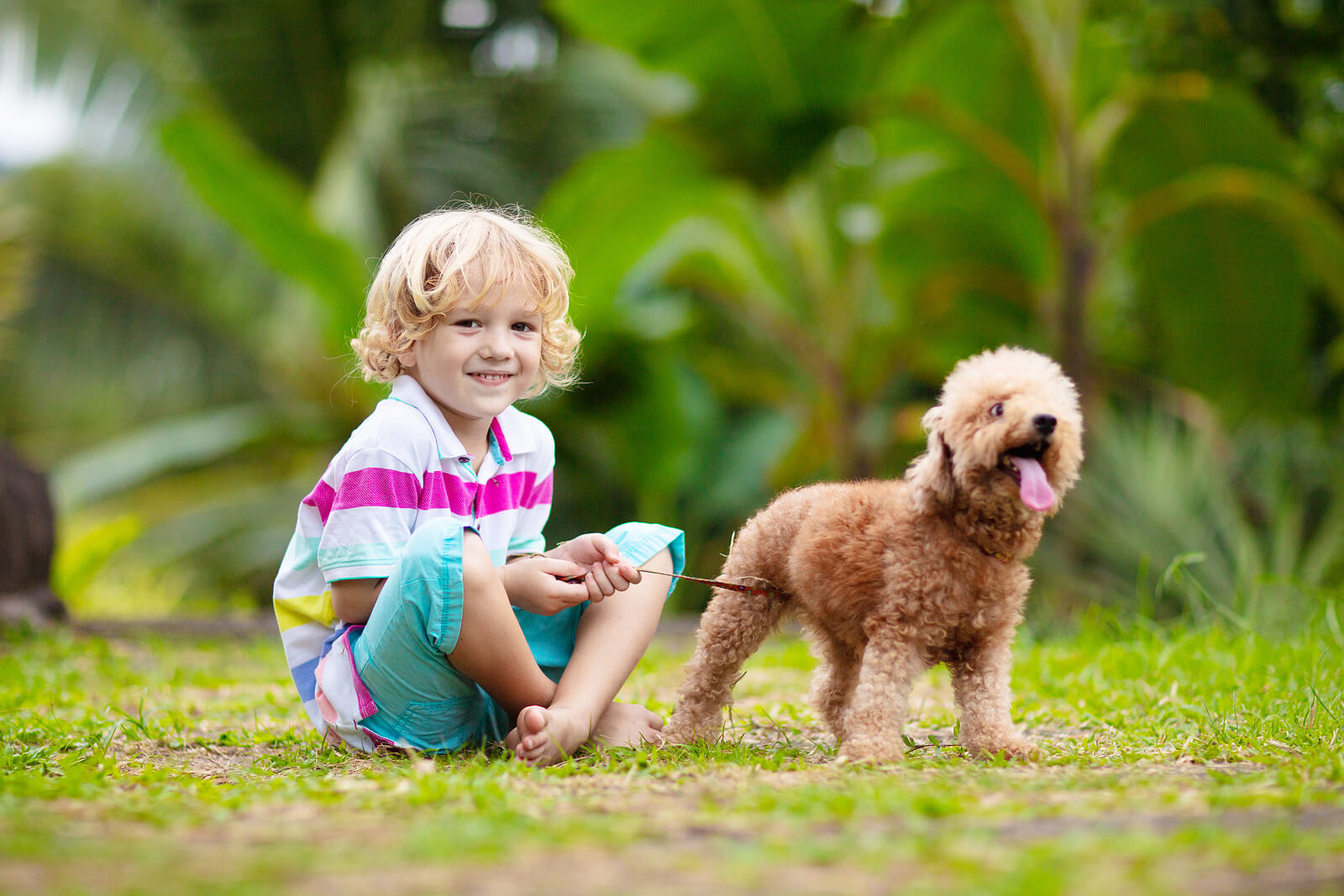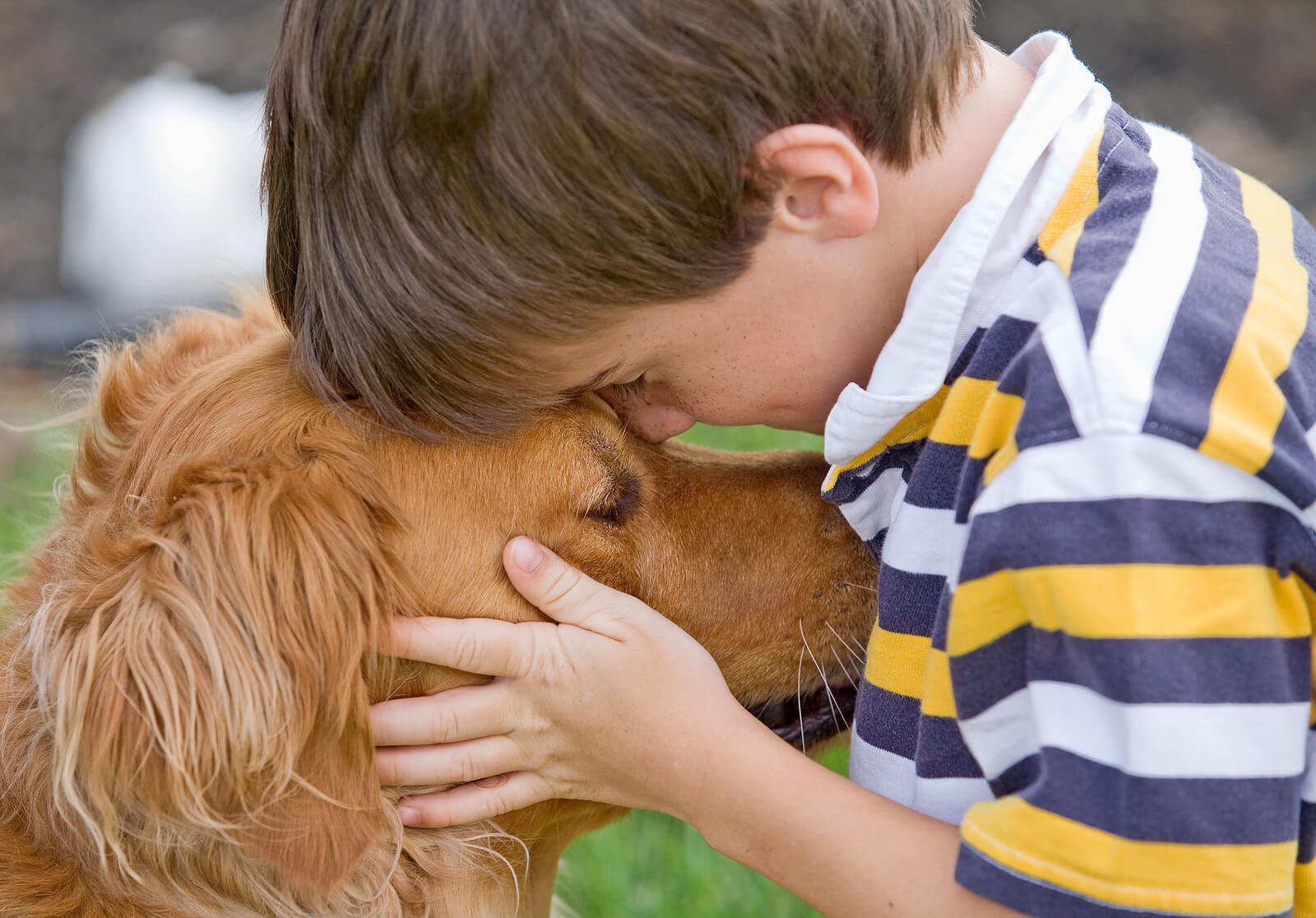13 Games for Children and Pets

Play is vital as a learning method for a huge number of species, both for animals and humans. For this reason, we want to present 13 games for children and pets, because both have much in common during their early years when it comes to developing in an adequate and balanced way.
Let’s remember, moreover, that when we talk about children and pets together, any activity can become a game. Sometimes it’s as simple as letting them understand each other. If we observe without being seen, we’ll see how the simplest object or the most insignificant action can be transformed into a source of entertainment for both. A blanket, a pencil, a cushion…
Learn more: 6 Child-Friendly Pets for Your Family

Children and pets: An intimate and beneficial relationship
Nor should we forget the importance of the presence of a pet in children’s lives. On a cognitive, social, physical, and emotional level, it will be very beneficial, as it stimulates them in all senses and helps them grow up with a stronger immune system and a more creative mind.
Studies have shown that children who grow up with a pet tend to do more exercise and physical activity. Not to mention the fostering of a sense of responsibility and the dedication and commitment that the child has to show towards their canine, feline, etc. companion.
The psychological impact on the mind is also shared between humans and animals: Both children and pets develop better through the use of positive reinforcement. That’s why it’s good to adapt activities to the needs of both–those of the child, on the one hand, and, on the other hand, those of the dog, cat, hamster…
Activities and games for children and pets
As is logical, there are many activities and games for children and pets that both will enjoy very much. The adventures they’ll go on will stay forever in your little one’s mind.
1. The classic ball
Both children and animals usually like to play ball. This activity is also very positive, as it gets them both to move, run, laugh, and do physical exercise, which is fundamental for children’s development.
The most classic game, when it comes to dogs, is to teach the animal to pick up the ball. However, you can also tie something round to a string and toss it toward your cat. You’ll see how your kitty has a great time trying to catch it.
2. Hide-and-seek
Another game that fundamentally works with dogs and sometimes also with cats is hide-and-seek. It’s an excellent way for your little one to reinforce their cognitive capacity, but it also helps to stimulate the pet in fields such as obedience or the stimulation of its senses. Furthermore, it also helps to enhance children’s creativity.
The mechanics are very simple: The child hides and the dog looks for them. Although it can also be improved by hiding objects that the pet has to look for, for example. Once the dog finds the hidden object, it’s a good idea to reward it.
3. Water games
Not all pets like water, but many do. In fact, it can be very good for both the animal and the child. So, when bath time comes, let the fun run wild with swimming races, hosepipe battles, etc. Of course, always under adult supervision.

4. Agility circuit
Agility is a kind of sport practiced with animals, generally dogs. It consists of creating a circuit that both the pet and the person accompanying it must overcome.
It’s easy to create a circuit at home. With a sturdy box, plastic tubes, and something else you have lying around, you can find a space in which to prepare and teach commands to the animal with the help of children.
In this case, the preparation of the circuit is as fun and interesting as the training of the animal, which has to learn to overcome obstacles. Then come the training sessions and the tests themselves. An activity that will last for weeks and will be great for children and pets.
5. Chasing prey
For this game, let’s tie a toy to a string. To make it more exciting, the string should be long enough for the toy to travel without stumbling or getting stuck, while the pet chases it and the child coils the rope.
In the end, the child will have a treat of the pet’s choice waiting for it.
Two fun variations of this game are the following:
- In a dimly lit room, use a flashlight or laser pointer. Your pet will exercise trying to hunt for the point of light.
- Hunt for soap bubbles.
6. Hide treats
For this activity, give the dog a sniff of its favorite treat and then hide it somewhere in the room. You can do it with several at the same time, as their super sense of smell, a thousand times more sensitive than humans, will go crazy with excitement with the smell and the dog will look for them with pleasure.
7. Tug of war
This game strengthens your pet’s limbs and demonstrates a great capacity for interaction. It consists of presenting the animal with a thick rope or rag that it can bite and resist the struggle.
In fact, as soon as it holds it with his teeth, pull on it, making moderate resistance, without sudden jerks that could hurt it. Pull and then loosen it. Your dog will shake it hard to get hold of it, but then you pull it again so that it knows it won’t be easy and will continue to resist.
8. Where is it?
Use three bowls, and in one of them, hide a treat that you’ve previously allowed your pet to sniff.
Move the bowls in its presence, it’s very likely that the animal won’t take its eyes off them. Stop the movement and let it sniff and earn its prize.
In the next attempts, the game will flow with greater participation from the pet because it’ll have understood what it’s all about.
9. Puzzle
A variation of the previous game is to hide three treats in three different parts of a silicone cupcake mold, reserved for playing with your pet, along with three tennis balls.
Allow it to sniff, find, and win the prize. When it finds all the treats, repeat the game with two and then one. The point is to hone your pet’s sense of smell and its hound spirit.
10. Practice routines
When going out for a walk, keep a routine as much as possible by following the same path. Changes, especially if they’re abrupt, aren’t good for your dog. Experts say, “It’s for there to be regularity in everything that has to do with dogs: Meals, exercises, sleeping hours, daily habits, etc. The dog will be able to tolerate alterations to its routine, but if they’re excessive, or if there’s never a routine, the dog will be in a state of discomfort. The dog will live in a permanent state of tension, which will affect its health.”
From time to time, however, take your dog to areas that are free of vehicles to play with balls or a frisbee.
“For dogs to be healthy and fit, they must get regular exercise. It’s the same as with people.”
11. Teach it to sit
In order for a dog to learn to sit, it must first learn to sit. One way is to help it sit by pushing down with your hands on its hind end as you say “sit”.
Once it’s sitting, reinforce the action positively. Then, with the treat-holding hand over its head, repeat the sitting voice. If it still doesn’t sit, continue to push it with your hand.
Insist until it does so without the need for a reward, always in good spirits, and every day, for a few minutes. Close the training day with the “come” gesture and welcome your pet with open arms… and a treat!
12. Teach your dog to shake
Commands and gestures accompany pet play and training. Dogs learn to sit and shake, among other tricks, if certain gestures are accompanied by a treat.
13. Recognize words
Dogs learn to associate objects with gestures and words. So, place several objects in front of it and, while naming and pointing to each one, order your pet to hold it and bring it to you.
You need to do this repeatedly and reward each success. This learning process will be very useful if it learns the activity with everyday objects that people at home need to have close by at some point. Like newspapers, walking sticks, shoes, hats, etc.
Without much training, when hearing the word “leash”, many recognize it as a sign to go for a walk and look for it to put it in the hands of their owners.
“…having a pet in the home has a positive influence on the way we treat them and the attitudes we have towards them, and it is these attitudes that exert a significant influence on our levels of human empathy.“
-Researchers in Educational Sciences Marta Nieto Palma and Andrés García Gómez-.
Keep reading: Pets: Why Are Children so Attracted to Animals?
Fun and therapeutic games for children and pets
Scientific evidence has clearly shown that interaction with pets has a positive effect on fundamental aspects of the experience.
Improved attention and social behavior, interpersonal interaction, humor, reduced stress, fear, and anxiety, as well as improved physical and mental health, especially cardiovascular health.
Ultimately, remember, too, that your imagination is the limit. So, apart from these 13 games for children and pets, I’m sure you can think of many more that are also interesting and that allow your kids to get close with those little animals that provide so much joy and fun.
All cited sources were thoroughly reviewed by our team to ensure their quality, reliability, currency, and validity. The bibliography of this article was considered reliable and of academic or scientific accuracy.
- Nieto-Palma, M., & García-Gómez, A. ACTITUDES HACIA LAS MASCOTAS, EMPATÍA Y ADOLESCENCIA Attitudes toward pets, empathy and adolescence Atitudes para os animais de estimação, empatia e adolescência. http://portal.amelica.org/ameli/jatsRepo/367/3671556002/3671556002.pdf
- Nuñez, I. P. Jugar con mascotas en el hospital. https://hospitalesinfantilesmejores.usal.es/jugar-en-el-hospital-2/jugar-con-mascotas-en-el-hospital-2/
- Ortiz Pulido E. (2020). Seis patas, dos amigos. Barcelona: Ediciones Martínez Roca.
- Santacruz Castillo, P. E. (2011). Estación de integración humana-canina (Bachelor’s thesis, PUCE). http://repositorio.puce.edu.ec/bitstream/handle/22000/12713/DOCUMENTO%20VOLUMEN%20I%20ESTACION%20DE%20INTERACCION%20HUMANO%20CANINO.pdf?sequence=1&isAllowed=y
This text is provided for informational purposes only and does not replace consultation with a professional. If in doubt, consult your specialist.
